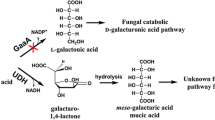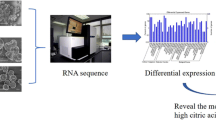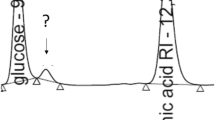Abstract
The filamentous fungus Aspergillus terreus has been successfully used for industrial production of itaconic acid (IA) for many years. The IA biosynthesis pathway has recently been characterized at a molecular genetic level as an IA gene cluster by a clone-based transcriptomic approach. The cluster consists of four genes, including genes for cis-aconitic acid decarboxylase (cadA), a predicted transcription factor (tf), a mitochondrial organic acid transporter (mttA) and an MFS (major facilitator superfamily) type transporter (mfsA). In this research, we performed expressed sequence tag (EST) analysis and systematic gene deletions to further investigate the role of those genes during IA biosynthesis in A. pseudoterreus ATCC32359. EST analysis showed a similar expression pattern among those four genes that were distinct from neighboring genes and further confirmed that they belong to the same biosynthesis cluster. Systematic gene deletion analysis demonstrated that tf, cadA, mttA and mfsA genes in the cluster are essential for IA production; deletion of any of them will either completely abolish the IA production or dramatically decrease the amount of IA produced. The tf gene plays a regulatory role in this cluster. Deletion of tf led to decreased expression levels of cadA, mttA and mfsA. More importantly, a significant amount of aconitic acid was detected in the cadA deletion strain but not in the other deletion strains. Therefore, by deleting only one gene, the cadA, we established a novel microbial host for the production of aconitic acid and other value-added chemicals from sugars in lignocellulosic biomass.






Similar content being viewed by others
References
Ambler JA, Roberts EJ (1948) The effect of pH on the stability of cis-aconitic acid in dilute solution. J Org Chem 13(3):399–402. https://doi.org/10.1021/jo01161a013
Bagavant G, Gole SR, Joshi W, Soni SB (1994) Studies on anti-inflammatory and analgesic activities of itaconic acid systems. Part 1. Itaconic acids and diesters. Ind J Pharm Sci 56:80–85
Bentley R, Thiessen CP (1955) Cisaconitic decarboxylase. Science 122(3164):330
Bentley R, Thiessen CP (1957a) Biosynthesis of itaconic acid in Aspergillus terreus. I. Tracer studies with C14-labeled substrates. J Biol Chem 226(2):673–687
Bentley R, Thiessen CP (1957b) Biosynthesis of itaconic acid in Aspergillus terreus. II. Early stages in glucose dissimilation and the role of citrate. J Biol Chem 226(2):689–701
Bentley R, Thiessen CP (1957c) Biosynthesis of itaconic acid in Aspergillus terreus. III The properties and reaction mechanism of cis-aconitic acid decarboxylase. J Biol Chem 226(2):703–720
Blazeck J, Miller J, Pan A, Gengler J, Holden C, Jamoussi M, Alper HS (2014) Metabolic engineering of Saccharomyces cerevisiae for itaconic acid production. Appl Microbiol Biotechnol 98(19):8155–8164. https://doi.org/10.1007/s00253-014-5895-0
Blumhoff M, Steiger M, Mattanovich D, Sauer M (2013) Targeting enzymes to the right compartment: metabolic engineering for itaconic acid production by Aspergillus niger. Metab Eng 19:26–32. https://doi.org/10.1016/j.ymben.2013.05.003
Bonnarme P, Gillet B, Sepulchre AM, Role C, Beloeil JC, Ducrocq C (1995) Itaconate biosynthesis in Aspergillus terreus. J Bacteriol 177(12):3573–3578
Calam CT, Oxford AE, Raistrick H (1939) Studies in the biochemistry of micro-organisms: itaconic acid, a metabolic product of a strain of Aspergillus terreus Thom. Biochem J 33(9):1488–1495
Cao H, Zheng Y, Zhou J, Wang W, Pandit A (2011) A novel hyperbranched polyester made from aconitic acid (B3) and di (ethylene glycol) (A2). Polym Int 260(4):630–634
Carroll A, Sweigard J, Valent B (1994) Improved vectors for selecting resistance to hygromycin. Fungal Genet Newsl 41:22
Chomczynski P (1993) A reagent for the single-step simultaneous isolation of RNA, DNA and proteins from cell and tissue samples. Biotechniques 15(3):532–534 536-537
Dai Z, Aryal UK, Shukla A, Qian W-J, Smith RD, Magnuson JK, Adney WS, Beckham GT, Brunecky R, Himmel ME, Decker SR, Ju X, Zhang X, Baker SE (2013) Impact of alg3 gene deletion on growth, development, pigment production, protein secretion, and functions of recombinant Trichoderma reesei cellobiohydrolases in Aspergillus niger. Fungal Genet Biol 61:120–132. https://doi.org/10.1016/j.fgb.2013.09.004
Eimhjellen KE, Larsen H (1955) The mechanism of itaconic acid formation by Aspergillus terreus. 2. The effect of substrates and inhibitors. Biochem J 60(1):139–147
Flipphi M, Sun J, Robellet X, Karaffa L, Feketa E, Zeng A, Kubicek CP (2009) Biodiversity and evolution of primary carbon metabolism in Aspergillus nidulans and other Aspergillus spp. Fungal Genet Biol 46(Suppl1):S19–S44
Geiser E, Przybilla SK, Friedrich A, Buckel W, Wierckx N, Blank LM, Bölker M (2015) Ustilago maydis produces itaconic acid via the unusual intermediate trans-aconitate. Microb Biotechnol 9(1):116–126. https://doi.org/10.1111/1751-7915.12329
Geiser E, Przybilla SK, Engel M, Kleineberg W, Büttner L, Sarikaya E, Hartog TD, Klankermayer J, Leitner W, Bölker M, Blank LM, Wierckx N (2016) Genetic and biochemical insights into the itaconate pathway of Ustilago maydis enable enhanced production. Metab Eng 38:427–435. https://doi.org/10.1016/j.ymben.2016.10.006
Gutierrez EN, Lamberti V (1978) Preparation of aconitic acid. United States patent, no. 4123459A
Hossain AH, Li A, Brickwedde A, Wilms L, Caspers M, Overkamp K, Punt PJ (2016) Rewiring a secondary metabolite pathway towards itaconic acid production in Aspergillus niger. Microb Cell Factories 15(1):130–130. https://doi.org/10.1186/s12934-016-0527-2
Hosseinpour Tehrani H, Geiser E, Engel M, Hartmann SK, Hossain AH, Punt PJ et al (2019) The interplay between transport and metabolism in fungal itaconic acid production. Fungal Genet Biol 125:45–52. https://doi.org/10.1016/j.fgb.2019.01.011
Huang X, Lu X, Li Y, Li X, Li JJ (2014) Improving itaconic acid production through genetic engineering of an industrial Aspergillus terreus strain. Microb Cell Factories 13:119–119. https://doi.org/10.1186/s12934-014-0119-y
Jaklitsch WM, Kubicek CP, Scrutton MC (1991) The subcellular organization of itaconate biosynthesis in Aspergillus terreus. J Gen Microbiol 137:533–539
Karaffa L, Kubicek CP (2019) Citric acid and itaconic acid accumulation: variations of the same story? Appl Microbiol Biotechnol 103(7):2889–2902. https://doi.org/10.1007/s00253-018-09607-9
Kin R, Sai T, So S (1998). Itaconate copolymer with quadratic nonlinear optical characteristic JP-Patent Patent No JPH10293331
Kinoshita K (1931) uber eine neue Aspergillus Art, A. itaconicus. Bot Mag Tokyo 45:45–50
Kobayashi K, Maruebi J, Kirimura K (2016) Bioproduction of trans- aconitic acid from citric acid by whole-cell reaction of Escherichia coli heterologously expressing the aconitate isomerase gene from Pseudomonas Sp. WU-0701. Chem Sel 1(7):1467–1471
Krull S, Hevekerl A, Kuenz A, Prüße U (2017) Process development of itaconic acid production by a natural wild type strain of Aspergillus terreus to reach industrially relevant final titers. Appl Microbiol Biotechnol 101(10):4063–4072. https://doi.org/10.1007/s00253-017-8192-x
Kuenz A, Gallenmüller Y, Willke T, Vorlop KD (2012) Microbial production of itaconic acid: developing a stable platform for high product concentrations. Appl Microbiol Biotechnol 96(5):1209–1216
Kumar V, Raveendiran N (2018) Synthesis, characterisation, biological and molecular docking studies of aconitic acid based co-polyester. Asian J Res Chem 11:723
Larsen H, Eimhjellen KE (1955) The mechanism of itaconic acid formation by Aspergillus terreus. 1. The effect of acidity. Biochem J 60(1):135–139
Li A, van Luijk N, ter Beek M, Caspers M, Punt P, van der Werf M (2011) A clone-based transcriptomics approach for the identification of genes relevant for itaconic acid production in Aspergillus. Fungal Genet Biol 48(6):602–611
Li A, Pfelzer N, Zuijderwijk R, Punt P (2012) Enhanced itaconic acid production in Aspergillus niger using genetic modification and medium optimization. BMC Biotechnol 12:57. https://doi.org/10.1186/1472-6750-12-57
Li A, Caspers M, Punt P (2013a) A systems biology approach for the identification of target genes for the improvement of itaconic acid production in Aspergillus species. BMC Res Notes 6:505–505. https://doi.org/10.1186/1756-0500-6-505
Li A, Pfelzer N, Zuijderwijk R, Brickwedde A, van Zeijl C, Punt P (2013b) Reduced by-product formation and modified oxygen availability improve itaconic acid production in Aspergillus niger (Vol. 97)
Lockwood LB, Nelson GE (1946) Some factors affecting the production of itaconic acid by Aspergillus terreus in agitated cultures. Arch Biochem 10:365–374
Michelucci A, Cordes T, Ghelfi J, Pailot A, Reiling N, Goldmann O, Binz T, Wegner A, Tallam A, Rausell A, Buttini M, Linster CL, Medina E, Balling R, Hiller K (2013) Immune-responsive gene 1 protein links metabolism to immunity by catalyzing itaconic acid production. Proc Natl Acad Sci 110(19):7820–7825. https://doi.org/10.1073/pnas.1218599110
Nelson GE, Traufler DH, Kelley SE, Lockwood LB (1952) Production of itaconic acid by Aspergillus terreus in 20 liter fermentors. Ind Eng Chem 44:1166–1168
Nowakows A (1973) Utilization of some tricarboxylic-acid cycle intermediates by mitochondria and growing mycelium of Aspergillus terreus. J Gen Appl Microbiol 79(Nov):19–29
Okamoto S, Chin T, Hiratsuka K, Aso Y, Tanaka Y, Takahashi T, Ohara H (2014) Production of itaconic acid using metabolically engineered Escherichia coli. J Gen Appl Microbiol 60(5):191–197. https://doi.org/10.2323/jgam.60.191
Riscaldati E, Moresi M, Federici F, Petruccioli M (2000) Effect of pH and stirring rate on itaconate production by Aspergillus terreus. J Biotechnol 83(3):219–230
Schmittgen TD, Zakrajsek BA, Mills AG, Gorn V, Singer MJ, Reed MW (2000) Quantitative reverse transcription-polymerase chain reaction to study mRNA decay: comparison of endpoint and real-time methods. Anal Biochem 285(2):194–204. https://doi.org/10.1006/abio.2000.4753
Shin WS, Park B, Lee D, Oh MK, Chun GT, Kim S (2017) Enhanced production of itaconic acid through development of transformed fungal strains of Aspergillus terreus. J Microbiol Biotechnol 27(2):306–315. https://doi.org/10.4014/jmb.1611.11054
Steiger MG, Punt PJ, Ram AFJ, Mattanovich D, Sauer M (2016) Characterizing MttA as a mitochondrial cis-aconitic acid transporter by metabolic engineering. Metab Eng 35:95–104. https://doi.org/10.1016/j.ymben.2016.02.003
van der Straat L, Vernooij M, Lammers M, van den Berg W, Schonewille T, Cordewener J, der Meer IV, Koops A, de Graaff LH (2014) Expression of the Aspergillus terreus itaconic acid biosynthesis cluster in Aspergillus niger. Microb Cell Factories 13:11–11. https://doi.org/10.1186/1475-2859-13-11
Vuoristo KS, Mars AE, Sangra JV, Springer J, Eggink G, Sanders JPM, Weusthuis RA (2015) Metabolic engineering of itaconate production in Escherichia coli. Appl Microbiol Biotechnol 99(1):221–228. https://doi.org/10.1007/s00253-014-6092-x
Werpy T, and Petersen G (2004) Top value added chemicals from biomass: volume I -- results of screening for potential candidates from sugars and synthesis gas. United States: N. Web. https://doi.org/10.2172/15008859
Yu JH, Hamari Z, Han KH, Seo JA, Reyes-Dominguez Y, Scazzocchio C (2004) Double-joint PCR: a PCR-based molecular tool for gene manipulations in filamentous fungi. Fungal Genet Biol 41(11):973–981
Funding
The research was supported by the US Department of Energy (DOE), Office of Energy Efficiency and Renewable Energy (EERE), Bioenergy Technologies Office (BETO), under Award No. DE-NL-0011937 and DE-NL-0030038.
Author information
Authors and Affiliations
Corresponding author
Ethics declarations
Conflict of interest
The authors declare that they have no conflict of interest.
Ethical approval
This article does not contain any studies with human participants or animals performed by any of the authors.
Additional information
Publisher’s note
Springer Nature remains neutral with regard to jurisdictional claims in published maps and institutional affiliations.
Rights and permissions
About this article
Cite this article
Deng, S., Dai, Z., Swita, M. et al. Deletion analysis of the itaconic acid biosynthesis gene cluster components in Aspergillus pseudoterreus ATCC32359. Appl Microbiol Biotechnol 104, 3981–3992 (2020). https://doi.org/10.1007/s00253-020-10418-0
Received:
Revised:
Accepted:
Published:
Issue Date:
DOI: https://doi.org/10.1007/s00253-020-10418-0




